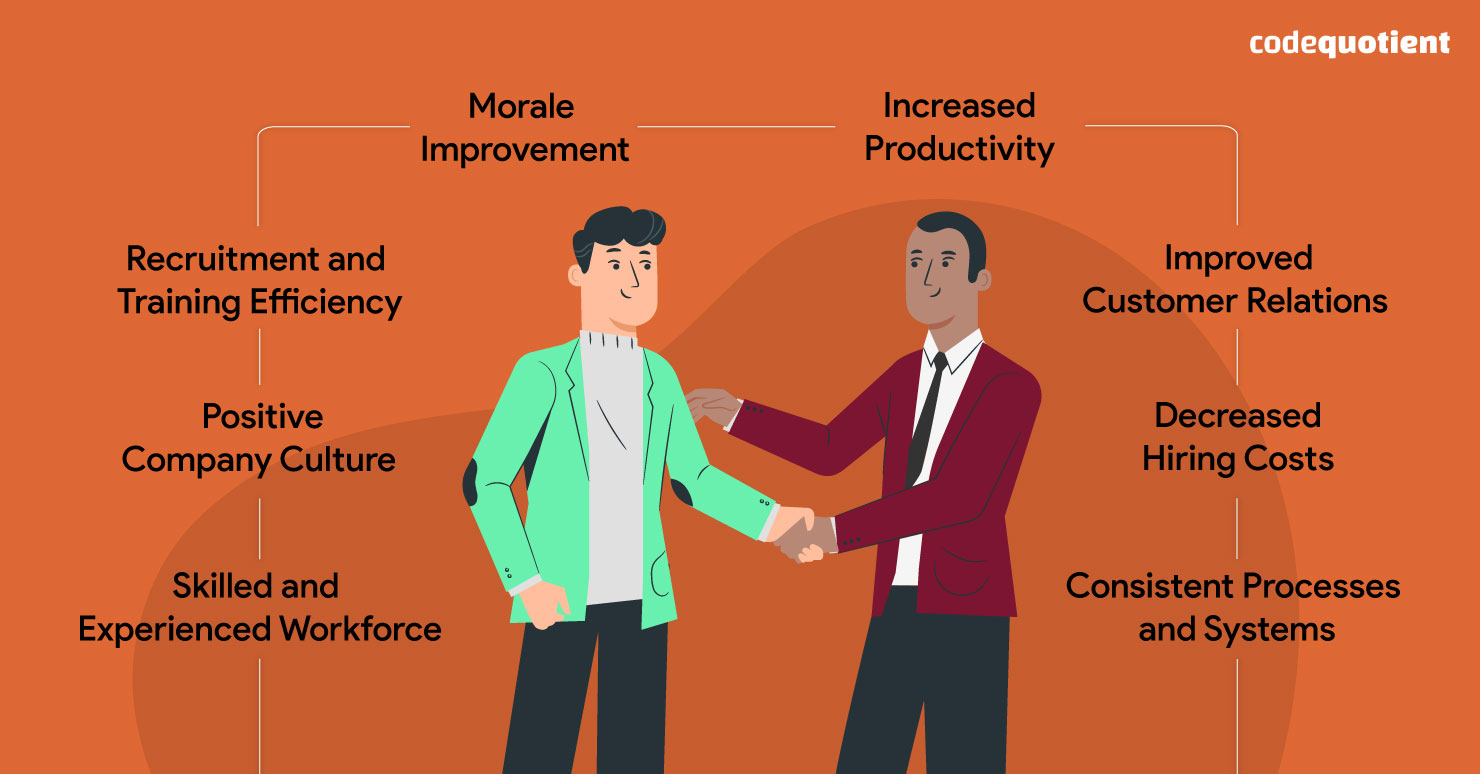Retaining top talent is critical to organisational growth. However, establishing a talent retention program is challenging. Furthermore, recruiting and retaining new employees is both costly and time-consuming—turnover hurts employees’ productivity and morale.
Even though modern companies have developed several retention methods, many organisations fail to comprehend the criticality of talent retention for sustained growth.
This article looks into the nitty-gritty of talent retention and explores how it can help organisations growth.
What is Talent Retention?
Talent retention is a set of practices and policies businesses implement to ensure their above-average employees stay with them for an extended time. It is possible to create a significant competitive advantage by retaining good employees.
The talent retention program applies to all businesses, micro, small or multinational corporations; and, the system benefits to leveraging the business further.
Top 8 Benefits of Talent Retention Employers Can’t Ignore

Talent retention benefits the organisation in a variety of ways. It not only helps retain talented employees, but it also aids in the recruitment of new employees and the motivation of current employees.
Here are some of the most sought-after benefits of talent retention:
1. Morale improvement
Employee morale can suffer in a revolving door environment. Employees who remain may have to take on heavier workloads or responsibilities to lose connections in the workplace. As a result, their motivation and satisfaction may hit rock bottoms.
Successful employee retention programs can boost employee morale, enable greater connectedness and engagement, and create contagions of positive emotions in the workplace.
2. Improved customer relations
Clients can notice when a company has a high turnover rate. Customers who want to support companies with positive cultures may be concerned about this. In addition, clients can get to know employees personally when companies keep them around.
This familiarity with employees can benefit businesses since clients may develop brand loyalty due to working with a favourite employee. In addition, developing relationships and rapport with customers is critical to increase repeat sales.
3. Positive company culture
Employer morale can suffer as a result of high turnover rates. Employees may find it difficult to be enthusiastic about their jobs if their coworkers leave your company. When employees want to stay with the company, the whole culture benefits.
Since everyone is an integral part of the company culture, when employees are happy and committed, it contributes to a positive work culture.
Therefore, good company culture can benefit current employees and attract top talent and improve customer relations, affecting sales.
4. Increased productivity
Someone starting a new job needs to establish good working relationships and solid communication channels with their coworkers – that social connection greases the wheels of collaboration and increases overall productivity.
Time lost due to miscommunication can quickly add up if the errors or misunderstandings are significant enough.
In fact, it can take 1 to 2-years for a new employee to reach the productivity level of the employee they replaced. Sure, some turnover is unavoidable. But, even a small productivity gain in employees who stay saves the company a significant amount of lost productivity, both for the employees and the HR teams who must deal with transitions.
5. Decreased hiring costs
Finding new team members can be expensive. Hiring recruiters, training employees, and providing sign-on bonuses can all add up to make a new hire. However, companies can reduce these costs by retaining their employees.
When managers are constantly hiring new employees, it can consume a significant amount of time and money. Companies can save money by investing in their current employees rather than recruiting new ones.
6. Highly skilled and experienced workforce
When an employee has been with the company for a while, they can expand their skills and relevant experiences. Rather than starting from scratch with a new employee, employers can build an effective workforce by investing in ongoing training and career development for current team members.
Employers can also benefit from promoting internally when filling a high-level position because their current employees already know the company and may have the necessary skills.
7. Consistent processes and systems
Having the same employees around makes it easier to maintain consistency in your processes and systems. When an employer hires a new employee, there may be a gap in how their systems operate.
A company with a small customer service department, for example, may fall behind on work if one of its employees departs.
Similarly, a new team member may be unfamiliar with all of the company’s policies and protocols, which may impede efficiency. Employers can ensure that their team fully understands how the company operates by retaining experienced employees.
8. Recruitment and training efficiency
The cost of replacing an employee is significant. For instance, after a company finds qualified candidates and successfully recruits and onboards them, they must be trained. But, if that new employee leaves, all of the money and time spent is gone.
Employers can drastically reduce recruiting costs by focusing on employee retention. Another option is to hire from within the organisation. The cost of internally training and reskilling an employee can save a company tens of thousands of rupees per person, annually.
Hire Top Tech Talent from CodeQuotient
Talent retention should be HR’s top priority, regardless of industry. A company cannot expand overnight, create a new customer base out of thin air, or eliminate competition—but your HR team can mitigate all of these on a smaller scale by increasing talent retention.
While a growing tech firm does not need large sums of money to retain tech talent, it does need to create an appealing culture, an engaged workforce, and promote collaboration to become a front-runner.
If you’d like to learn more about how CodeQuotient can help you find, hire, and retain tech talent, please contact us.




